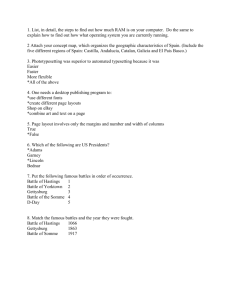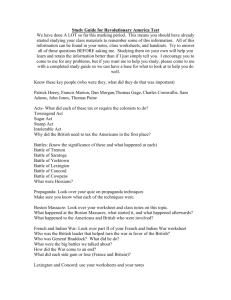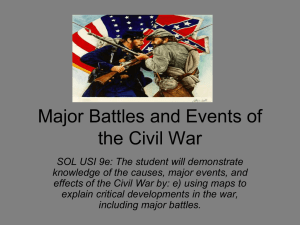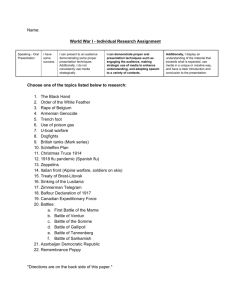Kamburov_Civil War Battles Lesson
advertisement
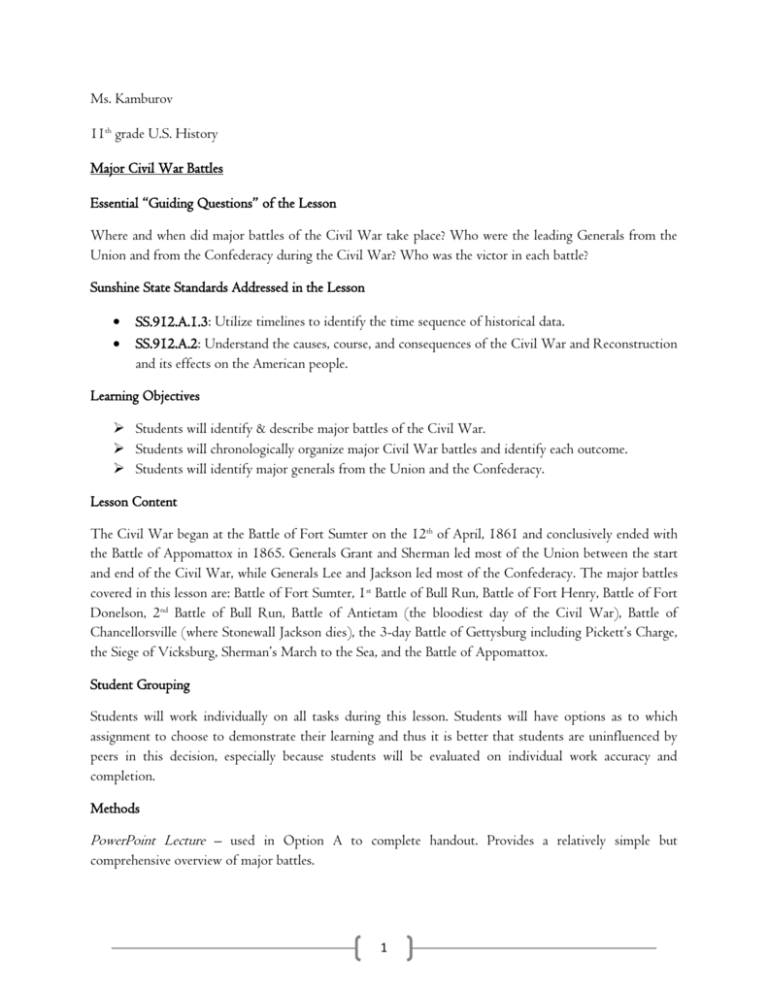
Ms. Kamburov 11th grade U.S. History Major Civil War Battles Essential “Guiding Questions” of the Lesson Where and when did major battles of the Civil War take place? Who were the leading Generals from the Union and from the Confederacy during the Civil War? Who was the victor in each battle? Sunshine State Standards Addressed in the Lesson SS.912.A.1.3: Utilize timelines to identify the time sequence of historical data. SS.912.A.2: Understand the causes, course, and consequences of the Civil War and Reconstruction and its effects on the American people. Learning Objectives Students will identify & describe major battles of the Civil War. Students will chronologically organize major Civil War battles and identify each outcome. Students will identify major generals from the Union and the Confederacy. Lesson Content The Civil War began at the Battle of Fort Sumter on the 12th of April, 1861 and conclusively ended with the Battle of Appomattox in 1865. Generals Grant and Sherman led most of the Union between the start and end of the Civil War, while Generals Lee and Jackson led most of the Confederacy. The major battles covered in this lesson are: Battle of Fort Sumter, 1st Battle of Bull Run, Battle of Fort Henry, Battle of Fort Donelson, 2nd Battle of Bull Run, Battle of Antietam (the bloodiest day of the Civil War), Battle of Chancellorsville (where Stonewall Jackson dies), the 3-day Battle of Gettysburg including Pickett’s Charge, the Siege of Vicksburg, Sherman’s March to the Sea, and the Battle of Appomattox. Student Grouping Students will work individually on all tasks during this lesson. Students will have options as to which assignment to choose to demonstrate their learning and thus it is better that students are uninfluenced by peers in this decision, especially because students will be evaluated on individual work accuracy and completion. Methods PowerPoint Lecture – used in Option A to complete handout. Provides a relatively simple but comprehensive overview of major battles. 1 Textbook Outline – to be completed for Option B, in which students read through the textbook to fill out the blanks in the handout. Guided Online Research – to be completed for Option C, the advanced level reading option. Students who choose this are capable of very independent work to complete the handout. Timeline Creation – assignment for Option 1, where students create a digital timeline through www.dipity.com. Perspective Letter – assignment for Option 2, where students write a creative letter home, speaking as if one of the generals detailing the battles. Historical Narrative – students write an objective narrative of the major battles for Option 3, which provides a more traditional assignment. Activities Opening Briefly introduce students to the background leading up to the Civil War, asking the “important questions to ask” from the section below. Allow about 5 minutes for brief discussion. Main Activity Students will select 1 of 3 options to attain the learning objectives, including which Generals were involved in each battle and each battle’s outcome. Time allotted should be that of at least the remainder of 50minute class period, roughly 40-45 minutes. o Option A: View the instructor’s Civil War PowerPoint and complete the chronological handout of major battles. o Option B: Read through the Civil War chapter in the textbook and complete the chronological handout of major battles. o Option C: Use the events section of the site http://www.history.com/topics/american-civil-war to complete the chronological handout of major battles. For this option, students may be sent to the school library or computer lab if the classroom is not equipped with a set of computers. Closing Students will select 1 of 3 assignment options and use the grading rubric to successfully complete all criteria. This will be assigned at the end of the class period and begun for homework. Students should also be given the next 50-minute class period to complete the assignment. o Option 1: Use the handout completed during class to create a timeline of the major battles in the Civil War using www.dipity.com and Matthew Brady’s photography of battle sites from the battle places section of http://www.archives.gov/research/civil-war/photos/. 2 o For each battle along the timeline, students must include the date, the victor (Union or Confederacy), a summary, and military generals involved. o Option 2: Write a “letter home” from the perspective of one of the generals, either from the Union side or the Confederate side, the major battles they fought in – including date, fellow generals, summary of the battle and the outcome. o Option 3: Compose a 2-page narrative of major battles of the Civil War listed in the handout. For each battle, name the generals involved, include the date of the battle, a brief overview and the outcome. o All assignments due at the end of the start of next class period to provide time at home to finish. Important Questions to Ask 1. What were the economic differences between the North and the South? How may this have influenced the start of the Civil War? 2. How did the North view the issue of slavery as opposed to the South? Did the North use slaves? 3. Why would the South oppose the election of President Lincoln? Materials U.S. History class textbook(s) Civil War PowerPoint presentation Major Civil War Battles handout Projector (or Smartboard) Battle places section of photography by Matthew Brady, available at http://www.archives.gov/research/civil-war/photos/ The site www.dipity.com for timeline option Events section of http://www.history.com/topics/american-civil-war for guided research option Access to computers and internet Evaluation & Rationale This lesson is part of a unit covering the Civil War and Reconstruction. Students will be evaluated on accurate completion of the Civil War Battles handout. It is essential that students complete this handout accurately because it is used in the second part of the lesson where students choose which assignment to complete. There are 3 different ways to complete the handout so that the students are differentiated based on reading comprehension level and learning style (guided viewing of a PowerPoint with extensive visuals, reading the grade-level textbook or guided research of the major battles on a specific advanced reading history site.) Students will also be evaluated on the accurate completion and creativity of the assignment they choose (timeline, letter or narrative). All three options use the handout to accurately and chronologically depict historical events. All of the options in this lesson cover the same content using different methods and learning styles. Some students will choose the more creative assignments, visual or 3 composition-wise while others choose a more traditional writing assignment. There is a unit test at the end of the unit to determine retention of accurate information, but students are also assessed on the quality of the work they submit. 4 Civil War (1861 – 1865) Union: North Confederacy: South Led by President Abraham Lincoln Led by Jefferson Davis Major battles Battle Details Victor Battle of Fort Sumter Confederate Beauregard fires on Fort Sumter, begins the Civil War Confederacy The Union army assaulted the Confederates. The battle raged back and forth, but finally the arrival of additional Confederate troops forced the Union to retreat Confederacy Union’s Grant takes Fort Henry and gains control of the Tennessee River Union Union’s Grant takes Fort Donelson & accepts surrender of Confederate army. Union gains control of Cumberland River Union April 12, 1861 1st Battle of Bull Run 1861 Battle of Fort Henry 1862 Battle of Fort Donelson 1862 2nd Battle of Bull Run Confederacy 1862 Battle of Antietam Union 1862 5 Battle of Chancellorsville Confederacy defeats Union army, Stonewall Jackson dies Confederacy Confederates’ Pickett’s Charge fails, many casualties & bloodiest battle Union 1863 Battle of Gettysburg 1863 Siege of Vicksburg Union 1863 Sherman’s March Union 1864 Battle of Appomattox Union 1865 6
